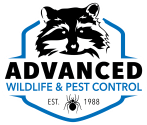There are various diseases that are carried by wild animals that can cause harm to humans or their four-legged companions. We will be highlighting some of the most serious, common, or notorious diseases that fall into this category in a series of blog posts. The first of the diseases we will be taking a closer look at is distemper, more correctly identified as Canine Distemper.
Despite its name, Canine Distemper can affect a wide range of animal species, from canines like wild and domesticated dogs, coyotes and wolves, to foxes, ferrets, raccoons, skunks, and even some cats. Pandas, semi-aquatic mammals like seals, elephants, and some primates are also susceptible but, obviously, that isn’t a huge concern for those of us here in Wisconsin. In the Midwest, the most common occurrence of this disease is in raccoons.
Canine Distemper is caused by a strand of an RNA virus that is in the same disease family as the measles and mumps. Unlike measles and mumps this disease cannot affect humans, but it can cause serious complications and even death for dogs who are exposed to the virus. This disease attacks the respiratory system, gastrointestinal system, and nervous system. While some animals may not show any symptoms, or have mild symptoms like a slight cough or runny nose, in others the disease can manifest as severe vomiting, high fever, labored breathing and lethargy. These symptoms can then develop further, into seizures, convulsions, paralysis, and death. The one symptom that is most likely to appear in infected dogs is the hardening of the pads of the feet and skin around the nose. That symptom is why the disease is also frequently called “hard pad disease”.
Exposure to Canine Distemper happens through the air, via coughing or sneezing. Symptoms typically present themselves within a month of exposure to the disease. As such, any animal that has contracted the disease should be kept in isolation for several months, as they can continue to be contagious for up to four months after the onset of symptoms. There is no cure for this disease, and once contracted by an animal the only option is to ease the animal’s suffering. Without treatment, the survival rate is only around 20 percent. However, with quick identification and proper care this rate can increase to up to 75 percent. While these dogs may survive the disease, any neurological damage caused by Canine Distemper is permanent. Although there is no cure, this disease can be prevented as there is a vaccine available. However, dogs who are not up to date on their shots and puppies who are too young to receive them are still at risk.
It is not uncommon to find raccoons wandering around in the daytime, appearing disoriented and almost drunk. While most people assume that these animals are sick with rabies (which is a disease we will discuss in more depth in its own blog post), it is more than likely this animal is sick with Canine Distemper. Even though this disease is not dangerous to humans, it can wreak havoc on local wildlife populations and local pets. It is important to call a professional wildlife removal service to come and remove the animal, and to keep all pets inside and away from the animal until it has been removed. Our technicians, upon finding infected animals, will humanely euthanize them to ease their pain and prevent future spread of the disease.
